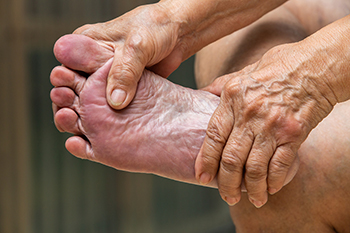

Maintaining proper foot care in elderly people can help prevent falls and injuries. Enduring a fall can affect the quality of life, and it can be difficult to complete daily activities. The muscle tissue in the feet can become thin as the aging process occurs, which may lead to a loss of feeling in the feet. It is beneficial to check the feet for any sores, cuts, or blisters that have developed, and this can be accomplished by using a mirror. A family member or caregiver may be able to help with this task by examining the soles of the feet. It is wise to wear shoes that fit correctly, which may aid in maintaining balance. Avoiding wearing shoes that are too tight may help to prevent blisters and corns from developing. Additionally, the feet will generally feel better when the toes are wiggled after sitting for long periods of time, and frequently elevating the feet may help to improve circulation. If you would like more information about how to care for elderly feet, it is suggested that you speak to a podiatrist who can provide you with useful tips.
Proper foot care is something many older adults forget to consider. If you have any concerns about your feet and ankles, contact Dale Delaney, DPM from InStride Kinston Podiatry Center. Our doctor can provide the care you need to keep you pain-free and on your feet.
The Elderly and Their Feet
As we age we start to notice many changes in our body, but the elder population may not notice them right away. Medical conditions may prevent the elderly to take notice of their foot health right away. Poor vision is a lead contributor to not taking action for the elderly.
Common Conditions
Susceptible Infections
Diabetes and poor circulation can cause general loss of sensitivity over the years, turning a simple cut into a serious issue.
If you have any questions please feel free to contact our office located in Kinston, NC . We offer the newest diagnostic and treatment technologies for all your foot and ankle needs.

The foot condition that is known as Morton’s neuroma is painful. It is caused by wearing shoes that do not have enough room in the toe area and it affects the nerve between the third and fourth toes. High heels can fall into this category, and women can develop this condition if high heels are worn often and for long periods of time. Patients may feel this affected nerve can be malignant, however, it is considered to be a benign growth. The pain is often felt in the ball of the foot, and it may be difficult to walk. Temporary relief may be found when wider shoes with lower heels are worn. There may be swelling that accompanies this ailment, and it can be helpful to elevate the feet. In severe cases, some patients may choose surgery that can remove the nerve, and normal activities may be resumed. If you have foot pain from for Morton’s neuroma, it is strongly suggested that you contact a podiatrist who can effectively diagnose and offer the correct treatment methods.
Morton’s neuroma is a very uncomfortable condition to live with. If you think you have Morton’s neuroma, contact Dale Delaney, DPM of InStride Kinston Podiatry Center. Our doctor will attend to all of your foot care needs and answer any of your related questions.
Morton’s Neuroma
Morton's neuroma is a painful foot condition that commonly affects the areas between the second and third or third and fourth toe, although other areas of the foot are also susceptible. Morton’s neuroma is caused by an inflamed nerve in the foot that is being squeezed and aggravated by surrounding bones.
What Increases the Chances of Having Morton’s Neuroma?
Morton’s neuroma is a very treatable condition. Orthotics and shoe inserts can often be used to alleviate the pain on the forefront of the feet. In more severe cases, corticosteroids can also be prescribed. In order to figure out the best treatment for your neuroma, it’s recommended to seek the care of a podiatrist who can diagnose your condition and provide different treatment options.
If you have any questions, please feel free to contact our office located in Kinston, NC . We offer the newest diagnostic and treatment technologies for all your foot care needs.

Many people who are active find they are prone to getting ankle sprains. These are defined as the ankle turning in or out beyond its normal range of motion, and can happen from suddenly twisting it. There are two types of ankle sprains that are common, which are known as inversion and eversion sprains. Studies have shown the likelihood of incurring an ankle sprain may be greater when it has been sprained before. An ankle that has healed from a sprain may be weaker, which may compromise walking. This may cause more weight to be put on the other ankle, and may become weaker. Performing ankle stretches is beneficial in strengthening the ankles which may help to prevent ankle sprains and regain a normal range of motion once it has healed. If you have sprained your ankle, it is suggested that you confer with a podiatrist who can help you with treatment and effective prevention techniques.
Ankle sprains are common but need immediate attention. If you need your feet checked, contact Dale Delaney, DPM from InStride Kinston Podiatry Center. Our doctor can provide the care you need to keep you pain-free and on your feet.
How Does an Ankle Sprain Occur?
Ankle sprains take place when the ligaments in your ankle are torn or stretched beyond their limits. There are multiple ways that the ankle can become injured, including twisting or rolling over onto your ankle, putting undue stress on it, or causing trauma to the ankle itself.
What Are the Symptoms?
Preventing a Sprain
Treatment of a Sprain
Treatment of a sprain depends on the severity. Many times, people are told to rest and remain off their feet completely, while others are given an air cast. If the sprain is very severe, surgery may be required.
If you have suffered an ankle sprain previously, you may want to consider additional support such as a brace and regular exercises to strengthen the ankle.
If you have any questions please feel free to contact our office located in Kinston, NC . We offer the newest diagnostic and treatment technologies for all your foot and ankle needs.

If you are the type of employee that must work all day on your feet, you might be at an increased risk of developing certain foot conditions. For example, cashiers must stand in more or less a static position all day at work. This can be quite detrimental to the health of the feet. To combat the ill effects of standing still all day, a worker might consider standing straight as opposed to being hunched over. This promotes proper alignment. Also, a worker could potentially complement periods of standing still by performing brief exercises. Therefore, how an employee stands can potentially have consequences for their foot health. If you are someone that spends a significant amount of time standing on your feet all day, it is suggested that you reach out to a podiatrist for suggestions on preventing foot problems.
While working on the feet, it is important to take the proper care of them. For more information about working on your feet, contact Dale Delaney, DPM from InStride Kinston Podiatry Center. Our doctor will treat your foot and ankle needs.
Working on Your Feet
Standing on your feet for long periods of time can cause stress and pain in your feet. Your whole body may experience change in terms of posture, back pain, bunions, callouses and or plantar warts. There are ways to avoid these conditions with proper foot care, smart choices and correct posture.
Positive Changes
Negative heeled shoe – Choosing this shoe type places the heel slightly lower than the ball of the foot. These are great for overall foot health. Find shoes that fit you correctly.
Go barefoot – Our feet were not designed to be enclosed for all hours of the day. Try to periodically expose your feet to air.
Eliminate Pain
Foot Exercises – Performing simple exercises, incorporating yoga and doing stretches are beneficial. This will allow increased blood flow to the area and muscles of the foot.
Achilles tendon – Stretching the foot out flat on the floor will relax the calf muscles and tendon. These exercises can be performed almost anywhere. Make sure you add these exercises to your daily regimen.
With a little bit of this information and knowing more about foot health, you will notice changes. Foot stretches and proper footwear will help with pain and prevent further issues.
If you have any questions please feel free to contact our office located in Kinston, NC . We offer the newest diagnostic and treatment technologies for all your foot and ankle needs.